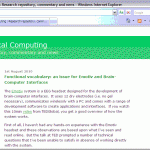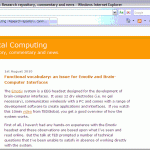From the point of view of an outsider, the utility and value of computer technology that provides emotional feedback to the human operator is questionable. The basic argument normally goes like this: even if the technology works, do I really need a machine to tell me that I’m happy or angry or calm or anxious or excited? First of all, the feedback provided by this machine would be redundant, I already have a mind/body that keeps me fully appraised of my emotional status – thank you. Secondly, if I’m angry or frustrated, do you really think I would helped in any way by a machine that drew my attention to these negative emotions, actually that would be particularly annoying. Finally, sometimes I’m not quite sure how I’m feeling or how I feel about something; feedback from a machine that says you’re happy or angry would just muddy the waters and add further confusion.
Category Archives: Experimental
Night of the Biocybernetic Zombies
Last month we played host to our project partners in REFLECT, an EU research project aimed at the development of pervasive-adaptive systems (NB. Ferrari + heart monitor = awesome). For the evening festivities a Shiverpool tour was arranged. Shiverpool is a Liverpool based theatre performance in which the audience is taken on a night tour of the city by a spirit guide who regales his audience with stories about Liverpool’s supernatural past. The guide is also accompanied by several ghoulish friends (or fiends, depending if your the target of the next scare or not). To add a little bit more spice to the evening we brought along the heart monitors and wired up five members of our group to see once more Who’s afraid of Ghost Stories? Unfortunately not everything went to plan, we had a few issues with the hardware causing a significant level of data loss preventing a detailed commentary about individual responses as was done with Ghost Stories, so instead I thought it would a good time to talk about the heart monitors we use and the software platform that runs The Body Blogger which we used for this event. Continue reading
Technical Difficulties
The Moody Web and Bodyblogger project are currently down for the time being as we transition to the new Twitter API. Should be back online over the weekend.
EDIT:
And we’re back online. Was expecting it take longer than my lunch break. Trying to sort this yesterday at Jelly Liverpool was a disaster as I’d somehow corrupted the mysql library trying to install CURL on the web server.
Making Data Meaningful
The problem with collecting in any amount of data is figuring out how to present that data in a manner that is meaningful for its intended audience. For example if you want to assess the physical effort you exert during a run a plot of physiological activity (e.g. heartbeat rate) against time will provide you with a relatively simple visual representation of how your body adapts to physical stress.
The Moody Web
We’re sporting a new look this month here at Physiological Computing, several in fact, as we’ve turned the web interface into an online mood ring. Using the online heartbeat rate of our body blogger (read more here on the BodyBlogger) the colour scheme of the site is set according to the users current physiological state.
Currently 4 colour schemes are supported: –
Each scheme is mapped onto a different physiological range which are as follows: –
- Relaxed: less than 60 beats per minute (bpm)
- Normal: 60 to 80 bpm
- Elevated: 80 to 100 bpm
- Burning: More than 100 bpm
These ranges and their implied state have been configured for our current body blogger who transitions through them on a daily basis (e.g. burning – running).
I’ll be updating more about the Moody Web later on this week, for the time being enjoy our take on adding a touch of the personal to the web.
Calm your spirits Kusagari, Red Steel 3 unlikely to use the Wii Vitality
In April there was a rumour going around that the next Red Steel (the third in the series) might support the Wii Vitality. The gameplay in Red Steel is a mixture of first person shooting and first person sword fighting. In the last Red Steel the combat system felt very similar to that of two-player fighting games like Street Fighter as apart from the basic sword fighting techniques you can perform with the Wii controller (e.g. blocking and striking) you could also pull off a range of special moves with different combinations of gestures and key presses. I’m a big fan of the Red Steel franchise and I believe it would be an interesting series to explore biofeedback based gameplay mechanics as both the mythos and the physical skillset being simulated in Red Steel lends itself well to intrinsically interesting physiological manipulations (e.g. as your playing a swordsman, “zen” powers aren’t too much of stretch for your suspension of disbelief). Below I’ve made a couple of suggestions as to what biofeedback based gameplay mechanics you might find in the next Red Steel game if it uses the Wii Vitality: –
The Body Blogger
A new page has been added to the navigation bar. “The Body Blogger” concerns our work in live blogging a user’s physiological state to the web and what impact it may have on the user as well as their audience. The body blog can be found at http://twitter.com/bodyblogger.
Who's afraid of Ghost Stories?
Last Saturday Steve and I went to see Ghost Stories over at the Playhouse theatre in Liverpool. The performance acts out a series of ghost stories a paranormal investigator has collected during his research into the supernatural. As one can imagine the aim of such an experience is to provide the audience with a good scare. To make things a little more interesting we decided to wire ourselves up and monitor the changes in our heartbeat during the performance thereby allowing us to compare our subjective experiences with our own physiological reactions. The results provide an interesting look into how our expectations of the event met with its reality as demonstrated by the recorded changes in our heartbeat.
Before continuing, consider this your SPOILER warning. If you haven’t seen Ghost Stories and intend to see it at the Lyric I suggest you hold off for now as I am going to have to give away some of the plot in order to explain events in their proper context. If you’ve already seen Ghost Stories or don’t intend to then continue on and see who indeed was afraid of the Ghost Stories.
Continue reading
Who’s afraid of Ghost Stories?
Last Saturday Steve and I went to see Ghost Stories over at the Playhouse theatre in Liverpool. The performance acts out a series of ghost stories a paranormal investigator has collected during his research into the supernatural. As one can imagine the aim of such an experience is to provide the audience with a good scare. To make things a little more interesting we decided to wire ourselves up and monitor the changes in our heartbeat during the performance thereby allowing us to compare our subjective experiences with our own physiological reactions. The results provide an interesting look into how our expectations of the event met with its reality as demonstrated by the recorded changes in our heartbeat.
Before continuing, consider this your SPOILER warning. If you haven’t seen Ghost Stories and intend to see it at the Lyric I suggest you hold off for now as I am going to have to give away some of the plot in order to explain events in their proper context. If you’ve already seen Ghost Stories or don’t intend to then continue on and see who indeed was afraid of the Ghost Stories.
Continue reading




